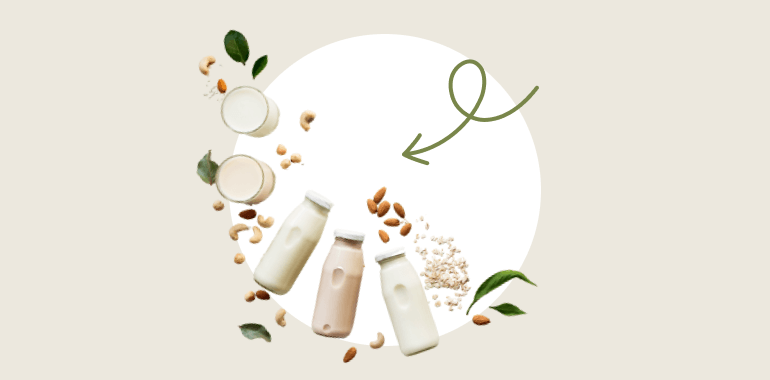Table Of Contents
Introduction: The General Differences Between Oat Milk and Almond Milk
In the growing landscape of plant-based alternatives, oat milk and almond milk stand out as popular dairy-free options. These two milk substitutes differ significantly in their flavor profiles—oat milk offers a creamy, slightly sweet taste, while almond milk provides a subtle nutty flavor. The texture varies too, with oat milk generally being richer and creamier, making it ideal for cereals and coffee, whereas almond milk’s thinner consistency works well in baking and creates fluffier textures.
Nutritionally, both alternatives provide different benefits. Almond milk typically contains more vitamins and minerals per serving, while oat milk often has more protein. However, nutrient content varies between brands, so checking labels is essential for making an informed choice between almond milk vs oat milk that aligns with your dietary needs.
Whether you’re lactose intolerant, following a plant-based diet, or simply exploring alternatives to dairy, understanding the differences between almond vs oat milk can help you select the option that best suits your taste preferences and nutritional goals.
Also, read – Why You Should Start Eating Vegetables For Breakfast
Oat Milk vs Almond Milk Taste Comparison
Almond and oat milk have gained popularity as dairy-free alternatives, each offering distinctive flavor profiles that make them suitable for different uses. Neither perfectly mimics cow’s milk, but each has unique characteristics worth exploring.
Both oat milk and almond milk don’t quite taste and feel like regular cow’s milk, but that is more of an adjustment than a drawback. Oat milk tastes starchy, while almond milk tastes like almonds and is thinner than conventional cow’s milk.
Oat milk has a naturally sweeter taste and contains more carbohydrates than almond milk, making it excellent for foamy beverages like lattes and baked goods where a creamy texture enhances the result. Almond milk, with its subtle nutty undertones and thinner consistency, works perfectly in smoothies, cereals, and savory dishes where you don’t want the milk to overpower other flavors.
General Taste: Oat milk has a naturally sweet flavor and a creamy consistency, whereas almond milk has a mildly nutty flavor and a watery texture.
The production process influences these taste differences. Almond milk comes from almonds soaked in water, then blended and strained to create a liquid. Similarly, oat milk follows this process but uses oats instead of almonds, resulting in different flavor profiles.
For those seeking something closer to traditional cow’s milk in flavor, oat milk generally provides a more familiar, neutral taste. However, if you prefer something with a distinct character, almond milk’s subtle nuttiness might be more appealing to your palate.
- Oat milk is the way to go if you’re seeking milk that tastes similar to cow’s milk.
- Almond milk, on the other hand, might be the best option for you if you’re searching for something with a little more flavor.
What Does Oat Milk Taste Like? The Creamy, Sweet Alternative
Oat milk is primarily made from water and whole oats. The production process involves soaking whole oats in water for several hours, allowing them to absorb the liquid thoroughly. After sufficient absorption, the oats are crushed and strained, creating the purest form of oat milk. Many brands then add their own ingredients to create distinctive flavor profiles.
- A slight oat aftertaste distinguishes oat milk from conventional cow milk in terms of flavor. Oat milk will differ less significantly in flavor than in appearance. More details are provided below.
Compared to cow’s milk, oat milk tends to be sweeter and smoother, with a pleasant mouthfeel that coats your palate. While the fat content differs from traditional dairy milk, manufacturers can control the density of their oat milk, affecting how creamy the final product is.
Regarding sweetness, oats contain natural sugars that convert to carbohydrates, making oat milk naturally sweet without added sweeteners. These natural sugars provide a subtle sweetness that isn’t overwhelming but adds to the milk’s pleasant taste.
A common misconception is that you can’t achieve the same texture as cow’s milk with plant alternatives. Oat milk proves this wrong, as even small amounts can create a creamy, satisfying texture that sets it apart from nut-based alternatives like almond milk.
Many wonder if oat milk tastes exactly like oatmeal. While related, oat milk has its own distinct flavor profile. Imagine draining the milk from a bowl of oatmeal with a hint of vanilla and brown sugar—this gives you a close approximation of oat milk’s unique taste.

What Does Almond Milk Taste Like & Why It’s So Popular
First-time almond milk drinkers might expect it to taste strongly of almonds, but that’s only partially accurate. In reality, almond milk has a light, pleasant flavor reminiscent of cereal milk or sweetened dairy milk with subtle nutty undertones.
Cinnamon, vanilla, chocolate, and honey are typical flavor elements. Of course, a lot relies on the brand of sweetened almond milk you choose to consume.
A common criticism of plant-based milks is their watery texture compared to cow’s milk. Almond milk, however, often defies this stereotype with its smooth, creamy consistency that resembles traditional dairy milk, making it enjoyable to drink straight or blend into beverages like lattes.
Regarding sugar content, many commercial almond milk products contain added sugars, but unsweetened varieties are low in carbohydrates. The high protein and fat content relative to carbohydrates means almond milk typically doesn’t spike blood sugar levels, making it suitable for those monitoring their glucose intake.
Texture varies between brands, so if your first experience doesn’t impress you, try different products until you find one that matches your preference. Even unsweetened almond milk retains a mild natural sweetness from the almonds themselves, making it a versatile addition to coffee and other beverages without overwhelming their flavor profiles.
Previously posted – Is Kombucha Good For Weight Loss
Calories in Oat Milk vs Almond Milk: The Numbers You Need to Know
Oat milk contains 130 calories per cup, along with 15 grams of carbohydrates, 2.5 grams of fat, 0 grams of saturated fat, 2 grams of fiber, 4 grams of protein, and 35 percent of your daily necessary calcium intake and 25 percent of your daily recommended vitamin D intake, according to the USDA.
In contrast, unsweetened almond milk provides approximately 39 calories per serving, making it a significantly lower-calorie option. The exact calorie count varies between brands and depends on whether the milk is flavored or sweetened.
Almond milk’s calorie and carbohydrate content increases in flavored or sweetened varieties, as reported by the USDA for a standard cup of milk.
- Compared to almond milk, oat milk has a lot more calories. However, almond milk might be a better option to cut calories because it has only 60 calories per serving compared to its 120-calorie counterpart.
Nutritional Value of Oat Milk vs Almond Milk
Comparing the nutritional profiles of different milk alternatives can be challenging because manufacturers use varying ingredients. The following comparison provides a general overview, but checking product labels remains essential for accuracy when comparing specific brands.
1. Carbohydrates
Oat milk contains the highest carbohydrate content among plant-based alternatives, with approximately 16g of carbs in an eight-ounce serving. This makes it less suitable for ketogenic or low-carb diets. By comparison, unsweetened almond milk typically contains only about 1g of carbohydrates per serving, making it a better choice for those limiting carb intake.
2. Protein
While almond milk provides slightly more protein than oat milk, neither qualifies as a rich protein source. Oat milk contains about 2-3 grams of protein per cup, compared to almond milk’s modest 1g. Both lack all nine essential amino acids, making them incomplete proteins. For higher protein content in plant-based milk, pea milk offers around 8g per serving, comparable to cow’s milk and soy milk.
3. Fat
Oat milk contains approximately 5 grams of fat, twice the amount found in almond milk (2.5 grams). This difference can be balanced through strategic dietary choices, such as using oat milk as a cream substitute in coffee or dishes where the primary flavor should remain unaltered.
4. Oat milk vs almond milk for weight loss
With numerous milk alternatives available today, choosing the right one depends on individual nutritional needs and preferences. Oat milk offers more protein than almond milk, while almond milk provides fewer calories and essential vitamins for muscle development. The choice between oat and almond milk for weight management ultimately comes down to personal preference, as neither option definitively promotes weight loss more than the other.
5. Micronutrients
Many non-dairy milk alternatives are fortified with calcium, vitamin B12, and vitamin D. This fortification is particularly important for vegetarians and vegans who might otherwise struggle to consume adequate nutrients without fortified foods. Comparing nutritional panels helps identify brands with the highest levels of specific nutrients you want to prioritize.
Previously posted – Is Tofu Good for Weight Loss? A Definitive Answer with Рroven Reasons
Carbs in Almond Milk: Important Facts for Low-Carb Dieters
- Unsweetened almond milk is an excellent choice for a nutritious keto diet because it only has 1.4 grams of carbs per cup (240 mL), 37% of the DV for calcium, and 46% of the DV for vitamin E.
Sweetened almond milk presents a challenge for those following ketogenic diets, containing 16 grams of carbohydrates and 15 grams of sugar per serving. This significant difference impacts your ability to include nutrient-dense, low-carb fruits and vegetables in your daily meal plan.
Choosing unsweetened almond milk allows for greater dietary flexibility on a low-carb eating plan, enabling you to allocate your carb allowance to other nutritious foods throughout the day rather than using it on sweetened beverages.
Health Benefits of Almond Milk
Almond milk’s micronutrient profile offers numerous health advantages, particularly for those with lactose intolerance or dairy sensitivities who need a nutritious alternative to cow’s milk.
- Could Improve Heart Health
One cup of almond milk provides over 16mg of vitamin E, a powerful antioxidant that helps protect against oxidative stress. This protection may enhance cardiovascular health and shield your body from conditions like cancer, arthritis, and diabetes, according to research published in academic journals.
- Bone Health
With 482 mg of calcium per serving, almond milk supports healthy bone maintenance. Studies have shown that calcium is essential not only for bone health but also for proper neuron and muscle function, making almond milk a valuable addition to a bone-supporting diet.
- Promote Skin Health
The vitamin E in almond milk may contribute to healthier skin. Research has linked this vitamin’s ability to neutralize free radicals and counteract UV radiation damage to improved skin health and appearance.
- Almond milk is good for diabetics
Almonds and almond milk offer potential benefits for people with diabetes. Rich in protein, healthy fats, and fiber while low in carbohydrates, these nuts may promote satiety, help regulate blood sugar, and support weight management, according to studies published in medical journals.
Previously posted – Paleo vs. Keto: Which Diet Will Work Best…
Health Benefits of Oat Milk
Oat milk shares many of the same health benefits as traditional dairy milk, including similar calorie content per cup. Like cow’s milk, oat milk contains substantial amounts of calcium and vitamin D, making it an excellent choice for adults and children seeking to develop and maintain strong bones.
- Promotes satiety
The high protein and fiber content in oat milk helps you feel full immediately and maintains that satiety for an extended period. This appetite-regulating effect can support weight management goals and promote healthier eating patterns throughout the day.
- Provides significant iron levels
A single cup of oat milk provides 10% of your daily recommended iron intake, making it a valuable iron source, especially for vegans and vegetarians who might miss out on other iron-rich foods. Adequate iron levels help prevent anemia by supporting healthy red blood cell production.
- Helps control cholesterol levels
Oats contain beta-glucan, a soluble fiber that helps maintain normal cholesterol levels. When processed into oat milk, the cholesterol-lowering effects of beta-glucan remain intact, making oat milk a heart-healthy beverage choice, as documented in published research.

Is Almond Milk Gluten Free: Important Considerations
Almonds are naturally gluten-free, so most almond milk manufacturers don’t face issues with gluten cross-contamination in their basic products. This makes plain, unflavored almond milk a generally safe choice for those with celiac disease or gluten sensitivity.
However, some flavored almond milk varieties may contain additives that include gluten. Always check ingredient labels carefully before purchasing flavored options to ensure they meet your dietary requirements, particularly if you have celiac disease or gluten intolerance.
Is Oat Milk Keto-Friendly?
Unfortunately, oat milk isn’t compatible with ketogenic diets due to its high carbohydrate content. Even unflavored or unsweetened varieties contain too many carbs to fit comfortably within low-carb dietary patterns.
- Unsweetened oat milk has roughly 12 grams of net carbs per eight-ounce serving, which is half or more of the daily net carb limit for a keto diet.
To maintain ketosis, you need to consume fewer than 20 to 25 grams of carbohydrates daily, or less than 5% of your total caloric intake. With a single serving of oat milk using up a substantial portion of this allowance, it’s not practical for those following strict ketogenic protocols.
Almond Milk vs Cow Milk: Key Differences
Cow’s milk stands as one of the world’s most nutrient-dense foods, often considered one of the original superfoods. With over 15 essential nutrients and a natural balance of carbohydrates, protein, and fats, it offers exceptional nutritional value.
Almond milk serves as an excellent plant-based alternative for those who cannot or choose not to consume dairy products. However, since water forms its primary component, almond milk contains less protein, fat, carbohydrates, and micronutrients than cow’s milk.
While fortified almond milk can provide some of the nutrients found in cow’s milk, the natural nutritional profile differs significantly. This difference makes almond milk a suitable alternative for those with specific dietary requirements, though it doesn’t match the complete nutritional package of traditional dairy.
Soy Milk vs Almond Milk: How They Compare
Soy milk most closely resembles cow’s milk nutritionally, containing approximately 95 calories and 7 to 12 grams of protein per cup. In contrast, almond milk has the lowest calorie content (30 to 50) but provides the least protein (only 1 gram per cup).
Soy milk contains glycosides, phytonutrients shown to have anticancer properties, and serves as a source of heart-healthy polyunsaturated fats. Almond milk, meanwhile, provides vitamins A and E along with heart-healthy monounsaturated fats, though its lower calorie count also means fewer overall nutrients.
The choice between these two plant-based alternatives depends on your nutritional priorities—soy milk offers more protein and a nutritional profile closer to dairy milk, while almond milk provides fewer calories and different beneficial compounds.
Coconut Milk vs Almond Milk: Making the Healthier Choice
- Almond milk is produced from almonds, while coconut milk is made from the flesh of coconuts. Both are alternatives to non-dairy milk.
- Coconut milk is creamier and more affluent than almond milk because it contains more fat. On the other hand, almond milk is more adaptable than coconut milk because it has a softer flavor.
Coconut milk contains more calories and saturated fat than almond milk, which may be a consideration for those monitoring cardiovascular health or calorie intake. Almond milk provides more essential vitamins and minerals, including calcium, potassium, and vitamin E, making it nutritionally advantageous in certain aspects.
Which Milk Alternative Is Best for Your Wellness Goals?
Choosing the right milk alternative depends on your specific health objectives and dietary requirements. For those focusing on weight management, unsweetened almond milk offers the lowest calorie option while providing beneficial vitamins and minerals.
If you’re looking to support heart health, both oat milk with its beta-glucan content and almond milk with its vitamin E may offer benefits, though they work through different mechanisms. Athletes and those building muscle might prefer soy milk for its higher protein content compared to other plant-based alternatives.
For those with specific dietary restrictions, the choice becomes clearer: almond milk works well for keto and gluten-free diets, while oat milk suits those who need to avoid nuts but can tolerate gluten (though certified gluten-free options exist). Individuals with multiple allergies might find coconut milk or rice milk safer alternatives.
The best approach is to consider your primary health goals, taste preferences, and any dietary restrictions, then select the milk alternative that aligns most closely with these factors. Don’t hesitate to experiment with different options until you find the one that best supports your unique wellness journey.
My name is Barbara Kovalenko. I hold a Bachelor's degree in Human Nutrition from Bogomolets National Medical University in Ukraine and a Master's degree from Boston University in the United States. Over the past few years, I have gained valuable experience as a nutritionist and have since decided to share my knowledge and expertise with a wider audience. Currently, I am working as a nutritional consultant with the Lasta app.










My brother recommended I might like this web site. He was once totally right. This put up actually made my day. You can not imagine just how much time I had spent for this information! Thank you!
Thank you for this informative comparison between oat milk vs almond milk! Your detailed breakdown of their taste, nutritional content, and uses is incredibly helpful for making an informed choice.
Hello, Jessica 👋
Happy to help with the info comparison of oat milk vs almond milk!